Table of contents
- Screwdriver tip for chains, cardan shafts and timing belts Maintenance and care of the final drive
- The cardan shaft
- The chain
- The timing belt
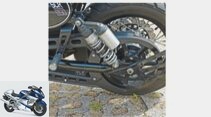
Ralf Petersen
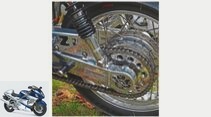



15th pictures
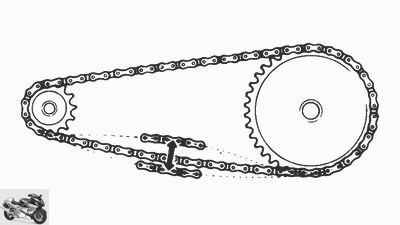
Ralf Petersen
1/15
Chain, cardan or toothed belt differ not only in their functionality, but also in terms of maintenance and repair options.
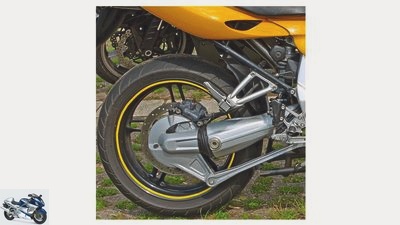
Ralf Petersen
2/15
Low maintenance and durable, but heavy and expensive. A cardan is the first choice for tourers.
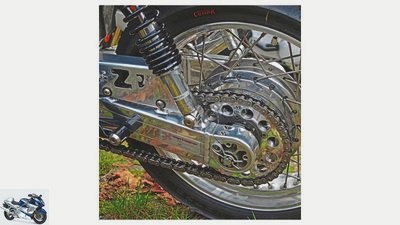
Ralf Petersen
3/15
The chain is the standard drive in motorcycle construction: efficient, light, inexpensive – but high-maintenance.
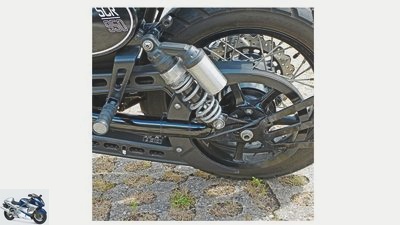
Ralf Petersen
4/15
A toothed belt works in a similar way to a chain, but does not need to be lubricated – a clean affair.
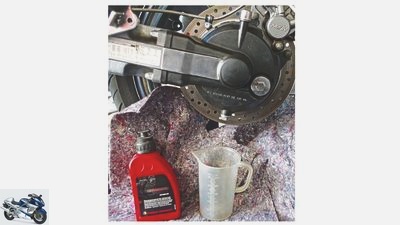
Ralf Petersen
5/15
Not so wild: assuming accessibility, an oil change on the cardan is also feasible for laypeople.
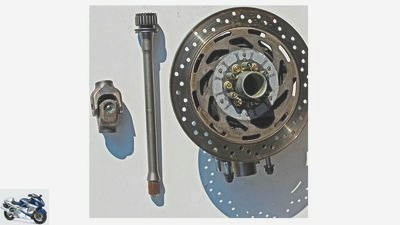
Ralf Petersen
6/15
Solid construction: cardan shaft, universal joint and final drive housing of a Honda NTV.

Ralf Petersen
7/15
The repair of the cardan final drive usually requires special tools and specialist knowledge.
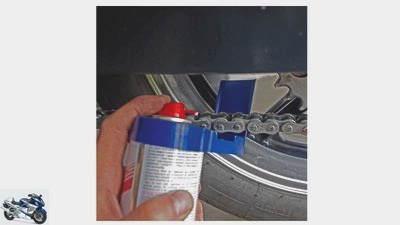
Ralf Petersen
8/15
If you lubricate well, you also drive well. Chain lubrication – here with chain spray and Sauber-Sepp.
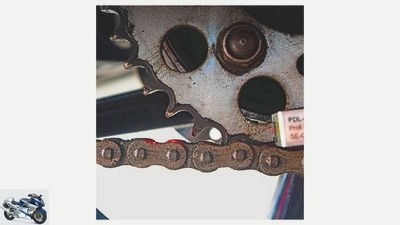
Ralf Petersen
9/15
Practical: A chain laser (better: chain alignment tester) facilitates the correct adjustment of the chain.
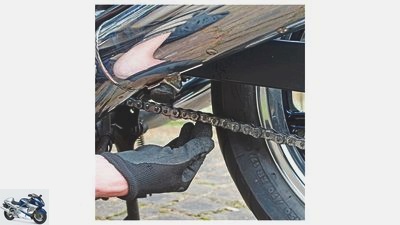
Ralf Petersen
10/15
Practice makes perfect: Setting the correct tension takes patience and experience.
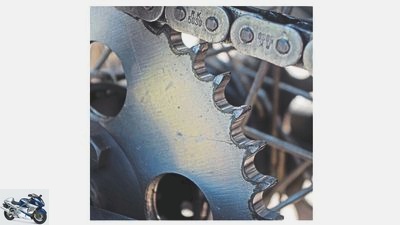
Ralf Petersen
11/15
Ripe for a change: Shark teeth are a sure sign of wear on the sprocket.
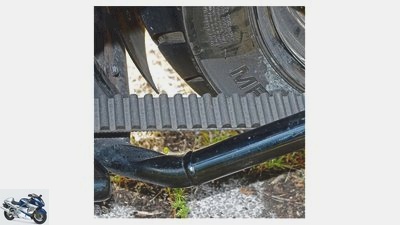
Ralf Petersen
12/15
Watchful eye: check the timing belt regularly for cracks and damage!
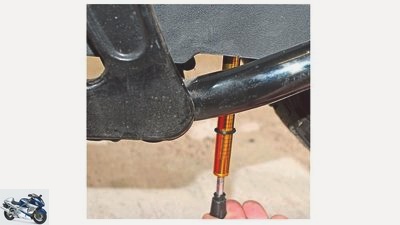
Ralf Petersen
13/15
Special tools: tension test using a belt tension meter on a Harley.
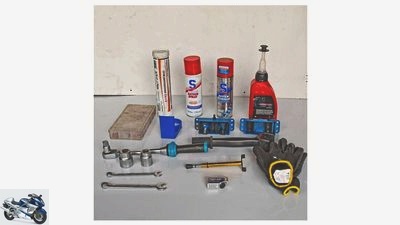
Ralf Petersen
14/15
This is required for maintenance: chain spray, cover protection, chain cleaner, brush / Kettenmax, chain laser, tools for loosening the rear axle / chain tensioner, gloves, torque wrench, cardan oil, seals, MoS2 grease, belt tension meter.
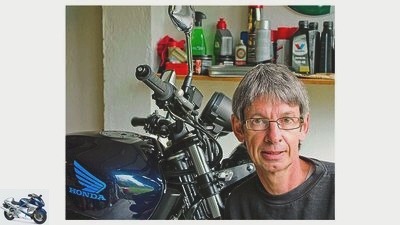
Ralf Petersen
15/15
Ralf Petersen works as a further education teacher at the VHS Duisburg and has been organizing mechanics courses for 22 years. 12 to 15 practical seminars on maintenance, repair and technology are offered every year. www.motorrad-schrauberkurse.de
counselor
workshop
Maintenance and care of chain, cardan shaft, toothed belt
Screwdriver tip for chains, cardan shafts and timing belts
Maintenance and care of the final drive
The so-called final drive of a motorcycle directs the power from the transmission output to the rear wheel. The chain, cardan and toothed belt each have their own advantages and disadvantages and also differ when it comes to maintenance and care.
06/05/2021
Motorcycles use one of three types to transmit the power of their combustion engine to the rear wheel: chain, cardan or toothed belt. These three variants differ not only in their functionality, but also in terms of maintenance and repair options.
The cardan shaft
With a cardan shaft, the power is transmitted to the rear wheel via a cardan shaft. Since it is a closed system, the cardan drive is as clean as it is maintenance-friendly and also very durable. The disadvantages are the high weight, a higher loss of power and, depending on the design, possibly stronger load change reactions.
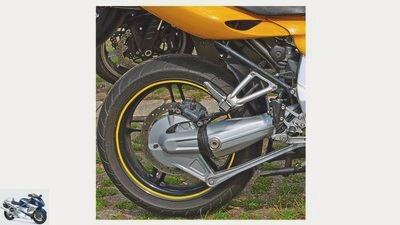
Ralf Petersen
Low maintenance and durable, but heavy and expensive. A cardan is the first choice for tourers.
Maintenance / repair: The maintenance of a cardan drive is usually limited to an oil change, which is carried out according to the manufacturer’s instructions (specification of the oil, procedure, etc.). If the machine has easily accessible drain / filler screws, this is relatively easy and can usually be carried out by laypeople without any problems. It is more difficult z. B. with some BMW boxers, because the effort is considerably greater. The change should be made when the machine is at operating temperature, and the old oil is checked for abrasion. The filler and drain plugs are screwed in again with a new sealing ring and the specified torque. The final drive housing should also be watched carefully on a regular basis. If oil leaks here due to defective sealing rings, it can get onto the tires or the brake disc – dangerous! The actual cardan shaft and the universal joint almost always run dry and are usually lubricated at the factory with MoS2 grease. If you remove a cardan swing arm in the course of other work, you can also supply the shaft and joint with new lubrication. A defective cardan is often noticeable through a stronger noise development. A damaged universal joint / shaft can, in principle, be replaced with reasonable effort. An elaborate (and therefore expensive!) Overhaul of the complex final drive is a workshop matter, because in addition to special tools you also need well-founded specialist knowledge. A used part in good condition can be an alternative.
The chain
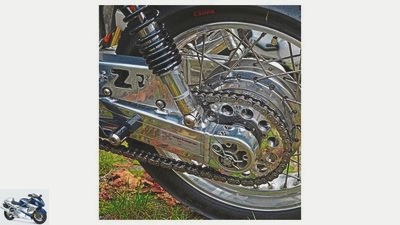
Ralf Petersen
The chain is the standard drive in motorcycle construction: efficient, light, inexpensive – but high-maintenance.
The secondary drive most commonly used in motorcycle construction is the chain. A chain drive is not only simply constructed, but above all can be produced inexpensively. If the chain is properly tensioned and lubricated, there will be little loss of performance. Low weight, a relatively simple change of the chain set and the possibility to change the gear ratio with the help of larger / smaller sprockets are further advantages of the chain. The biggest disadvantage is their more complex maintenance (lubrication, cleaning and tensioning) as well as the limited service life.
Maintenance / repair: Unfortunately, the chain of a modern motorcycle runs relatively unprotected because of the poor chain guard and therefore has to be re-lubricated regularly (every 300–500 km!) And cleaned if necessary. Thanks to modern O-ring chains, however, only external lubrication is required. Insufficient lubrication leads to high wear, loss of performance and stronger load change reactions. A well-lubricated chain can last up to 40,000 km, neglected examples are often at the end of their service life after less than 10,000 km. Commercially available chain spray is used for lubrication, which protects against corrosion and reduces friction. The chain should be clean and dry before application. Light soiling can be removed with a plastic brush. A special chain cleaner can be used for heavy soiling. A cleaning device called Kettenmax is also practical, which cleans the chain from all sides with the help of small brushes and a cleaning fluid and keeps the mess that occurs within limits.
For lubrication place the motorcycle on the main stand or assembly stand. It is best to cover the tire and rim well with cardboard. A splash guard (e.g. Sauber-Sepp) does a good job on the go. Spray chain spray on the inside of the chain on the lower chain strand while turning the wheel by hand. After lubricating, let it stand as long as possible so that the propellant evaporates. Never drive off immediately afterwards, otherwise the lubricant will be spread over the rim, brake disc and tire. An alternative to spray are permanent lubrication systems such. B. the Scottoiler. If adjusted correctly, it is quite efficient, but also relatively expensive.
Since a chain elongates continuously over time, the tension must be checked regularly. If it is too tight, the chain will stretch excessively and possibly affect the suspension. The consequences are extremely high wear and tear and increased pressure on the gearbox output bearing. In the worst case, the chain can even break. A chain that is tensioned too loosely whips and hits when the accelerator is released, wears out faster and in extreme cases can jump off or jump over.
For tensioning jack up the motorcycle so you can turn the rear wheel. Older chains are often unevenly elongated, so you can check the slack in the middle of the lower chain strand by lifting the chain with your fingers. The wheel is turned a little further and checked until the tightest point has been found, because that is decisive for the tension. A chain that is very unevenly elongated must be replaced. The slack in the chain is theoretically okay if it is around 3–5 cm when the machine is jacked up (see manual!). The chain must still have play when fully loaded (with driver / luggage!). Depending on the design of the machine, the game changes to a greater or lesser extent with or without a load. The only way to do this is to try it out with the help of a second person.
For correction Put the tension into gear and loosen the rear axle nut, if necessary remove the split pin etc. beforehand. To tension the chain, the rear wheel is pulled back (this happens automatically by the chain tensioner), to loosen it is pushed forward (after loosening the chain tensioner, press / hit the wheel vigorously). Most chain tensioners have an adjusting screw secured by a lock nut. The chain is tightened or loosened by evenly turning the screws on both sides. Do this alternately in quarter turns until the chain reaches the correct slack. There are (more or less exact) markings on the swing arm and the chain tensioners. The markings must be in the same position on both sides of the swing arm, otherwise the wheel will skew and affect the handling. A chain laser is also suitable for checking the escape. You put it on the chain wheel and let the laser point wander along the chain by turning it. If the point is not always in the same place on the chain links, the alignment is not correct. After tightening the axle nut (observe the torque), it is essential to check the chain tension again.
One Chain is worn out, if it is unevenly elongated or, despite correct tension, it can be lifted off more than 3 millimeters from the end of the sprocket with a screwdriver. Sometimes there are also wear indicators on the chain tensioner. Another indication are so-called shark teeth. The teeth of the sprocket become increasingly pointed due to abrasion over time, can then no longer withstand the enormous forces and bend, so that in extreme cases the chain slips over the sprocket. But also lateral play, twisted bolts, defective rollers and noticeably sluggish or easy-to-move chain links or defective sealing rings require a careful visual inspection. The complete chain set (i.e. chain, sprocket and sprocket) has to be replaced when changing, which is quite demanding in terms of screwdriving technology. The prices are of course very different depending on the type of motorcycle and quality. If you do not use a riveted chain but an endless chain, the swing arm must be removed. At the same time you should definitely check the shock absorbers and the bearing in the sprocket carrier.
The timing belt
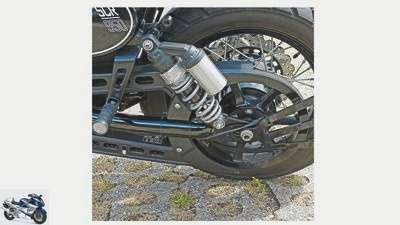
Ralf Petersen
A toothed belt works in a similar way to a chain, but does not need to be lubricated – a clean affair.
The alternative to the chain drive is the toothed belt, which has an almost identical principle but is made of a different material. Its main advantage is the lower maintenance requirements. It does not need to be lubricated, is quieter, has less load change reactions due to the elasticity of the belt and a service life of approx. 40,000 km. However, it is wider and therefore requires more space and has a slightly higher loss of power than a chain drive. Since it is made of rubber reinforced with nylon or Kevlar, it ages and can become brittle and crack. It is mainly used in Harley-Davidson and Buell, but also in some BMWs. Specialists also offer a conversion from a chain to a toothed belt, the cost of which is around 1,500 euros.
Maintenance / repair: If the belt drive is making screeching noises, the rear wheel is often not properly adjusted. In Harley forums, z. B. deer tallow recommended as a solution. In principle, however, the belt should not be lubricated, otherwise dirt particles will collect and have an abrasive effect. As with a chain, the tension must of course be controlled. As a rule, however, retensioning is required much less often, often only after 8,000 km. The tension is usually checked with the help of a special belt tension meter, which builds up a corresponding pressure. It is held by the rubber knob and pressed against the belt from below with the angle piece. The procedure differs depending on the design, so it is essential to observe the information in the manual!
If the Belt retightened the sequence roughly corresponds to that of the chain. The wheel is shifted via clamps on the swing arm. This must of course be done equally on both sides, the correct alignment can also be checked with a laser here. A belt that is tensioned too tightly can tear or damage the transmission output bearing. Regular visual checks of the belt and pulley for possible damage are also important, especially gravel can severely damage the drive.
A Replacement of the toothed belt is planned after approx. 40,000 kilometers and requires the swing arm to be removed. Depending on the model, the belt pulleys and the shock absorbers are changed in addition to the belt. Since the effort is very different, the prices for it are between 180 and 800 euros.
Related articles
-
Basics: chain, cardan, toothed belt
archive counselor workshop Basics: chain, cardan, toothed belt Basics: chain, cardan, toothed belt Advantages and disadvantages explained Toothed belt,…
-
Tips for mechanics – correct motorcycle chain maintenance
Photo: Ralf Petersen 13th pictures Ralf Petersen 1/13 / 1 / A typical lack of maintenance: everything sparkling clean, even the chain. Ralf Petersen 2/13…
-
counselor workshop Change chain kit Change chain kit Change chain kit Worn drive chains usually draw attention to themselves when driving with cracking…
-
Screwdriver tip – care and inspection of the suspension struts
Photo: Ralf Petersen 14th pictures Ralf Petersen 1/14 1: Classic, beautiful and easy to adjust: stereo shock absorbers. Ralf Petersen 2/14 2: Efficient -…
-
Tips for mechanics: Maintenance of motorcycle cooling systems
Ralf Petersen 15th pictures Ralf Petersen 1/15 We explain how the maintenance of a cooling system works. Ralf Petersen 2/15 This is needed for…
-
counselor workshop Change chain set Change chain set Replace the pinion, toothed wheel and drive chain Regular chain maintenance can delay the moment of…
-
Tension the chain correctly – it’s all about tension
mps photo studio counselor workshop Tension the chain correctly – it’s all about tension Tension the chain properly It’s all about the tension Is the…
-
Screwdriver tip: retreading wheels
Ralf Petersen 15th pictures Suzuki 1/15 So that everything runs smoothly. The screwdriver tip for everything to do with bikes. Ralf Petersen 2/15 What…
-
Advice: replace chain and sprockets
Schermer 5 pictures 1/5 The chain can be professionally riveted using a special tool (from around 100 euros). 2/5 Before installing the new chain kit,…
-
Clean and maintain motorcycle chains
archive accesories Clean and maintain motorcycle chains Advice: chain maintenance How do I properly care for the chain on my motorcycle?? Your…